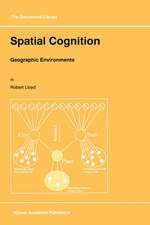Geographical Education in a Changing World: Past Experience, Current Trends and Future Challenges: GeoJournal Library, cartea 85
Editat de John Lidstone, Michael Williamsen Limba Engleză Hardback – 6 iun 2006
The underpinning assumption is that experiences gained in one country will be of real interest to educators in another. The book is part of the work of the Commission on Geographical Education of the International Geographical Union. Part 1, written in a global context, focuses on the distinctive traditions of school geography. Part 2 reviews the contemporary state of school geography ona broad continental basis with each chapter including national case studies, written by experts drawn from those countries. The final parts comprises chapters that extrapolate from the present and point to likely future developments in the subject, again with examples drawn from various countries.
| Toate formatele și edițiile | Preț | Express |
|---|---|---|
| Paperback (1) | 943.43 lei 43-57 zile | |
| SPRINGER NETHERLANDS – 18 noi 2010 | 943.43 lei 43-57 zile | |
| Hardback (1) | 951.77 lei 43-57 zile | |
| SPRINGER NETHERLANDS – 6 iun 2006 | 951.77 lei 43-57 zile |
Din seria GeoJournal Library
- 15%
 Preț: 642.51 lei
Preț: 642.51 lei - 15%
 Preț: 632.70 lei
Preț: 632.70 lei -
 Preț: 396.78 lei
Preț: 396.78 lei - 18%
 Preț: 948.92 lei
Preț: 948.92 lei -
 Preț: 430.59 lei
Preț: 430.59 lei - 18%
 Preț: 899.69 lei
Preț: 899.69 lei - 15%
 Preț: 581.79 lei
Preț: 581.79 lei - 18%
 Preț: 938.34 lei
Preț: 938.34 lei - 18%
 Preț: 888.80 lei
Preț: 888.80 lei - 15%
 Preț: 703.85 lei
Preț: 703.85 lei - 18%
 Preț: 890.68 lei
Preț: 890.68 lei - 24%
 Preț: 777.65 lei
Preț: 777.65 lei -
 Preț: 400.65 lei
Preț: 400.65 lei - 18%
 Preț: 785.55 lei
Preț: 785.55 lei - 18%
 Preț: 946.55 lei
Preț: 946.55 lei - 15%
 Preț: 661.02 lei
Preț: 661.02 lei - 18%
 Preț: 945.79 lei
Preț: 945.79 lei - 15%
 Preț: 637.28 lei
Preț: 637.28 lei - 15%
 Preț: 637.59 lei
Preț: 637.59 lei - 15%
 Preț: 637.46 lei
Preț: 637.46 lei - 15%
 Preț: 635.31 lei
Preț: 635.31 lei - 20%
 Preț: 568.44 lei
Preț: 568.44 lei - 15%
 Preț: 645.79 lei
Preț: 645.79 lei - 20%
 Preț: 569.86 lei
Preț: 569.86 lei - 15%
 Preț: 651.99 lei
Preț: 651.99 lei - 15%
 Preț: 639.41 lei
Preț: 639.41 lei - 15%
 Preț: 643.48 lei
Preț: 643.48 lei - 15%
 Preț: 663.60 lei
Preț: 663.60 lei - 15%
 Preț: 651.99 lei
Preț: 651.99 lei - 15%
 Preț: 651.02 lei
Preț: 651.02 lei -
 Preț: 390.63 lei
Preț: 390.63 lei -
 Preț: 395.63 lei
Preț: 395.63 lei
Preț: 951.77 lei
Preț vechi: 1160.70 lei
-18% Nou
Puncte Express: 1428
Preț estimativ în valută:
182.15€ • 189.46$ • 150.37£
182.15€ • 189.46$ • 150.37£
Carte tipărită la comandă
Livrare economică 14-28 aprilie
Preluare comenzi: 021 569.72.76
Specificații
ISBN-13: 9781402048067
ISBN-10: 1402048068
Pagini: 244
Ilustrații: XV, 255 p.
Dimensiuni: 155 x 235 x 19 mm
Greutate: 0.63 kg
Ediția:2006
Editura: SPRINGER NETHERLANDS
Colecția Springer
Seria GeoJournal Library
Locul publicării:Dordrecht, Netherlands
ISBN-10: 1402048068
Pagini: 244
Ilustrații: XV, 255 p.
Dimensiuni: 155 x 235 x 19 mm
Greutate: 0.63 kg
Ediția:2006
Editura: SPRINGER NETHERLANDS
Colecția Springer
Seria GeoJournal Library
Locul publicării:Dordrecht, Netherlands
Public țintă
ResearchCuprins
Traditions In School Geography.- Researching Change and Changing Research in Geographical Education.- Messages from the Past.- Turning Points in Geographic Education.- Changing Philosophies in Geographical Education from the 1970s to 2005 An International Perspective.- Changing Learning and Teaching.- Changing Assessment.- Contemporary School Geography.- School Geography and International Trends.- Geography in Europe.- Geographical Education in North America (Canada and the United States of America).- Geography in Australasia.- Geographical Education in East Asia.- Geographical Education in South America.- The Future Of School Geography.- Whither School Geography?.- Geography and New Technologies.- Geography and Sustainability The Future of School Geography?.- Discerning Citizenship in Geography Education.- Promoting Lifelong Learning through Geographical Education.
Textul de pe ultima copertă
The status of geography in school curricula varies across the globe. Geography, as a discrete subject, has, in some countries, established a strong position in both primary and secondary schools while in others it has a weaker position, often a component of integrated and cross-curricular arrangements. Globally, the trend is for geography's status to be challenged. A central theme of this book is the location of geography in school curricula with particular reference to centrality and marginality. A second theme relates to the subject status of geography. A third theme relates to the spirit and purpose of school geography and the traditions that underpin the subject and how these are changing. A fourth theme relates to the way geography is being seen by curriculum planners as contributing to the achievement of governmental aims for society in general. A fifth theme concerns the human and material resources infrastructure. Finally, what of the future?
The underpinning assumption is that experiences gained in one country will be of real interest to educators in another. The book, is part of the work of the Commission on Geographical Education of the International Geographical Union. Part 1, written in a global context, focuses on the distinctive traditions of school geography. Part 2 reviews the contemporary state of school geography on a broad continental basis with each chapter including national case studies, written by experts drawn from those countries. The final parts comprises chapters that extrapolate from the present and point to likely future developments in the subject, again with examples drawn from various countries.
The underpinning assumption is that experiences gained in one country will be of real interest to educators in another. The book, is part of the work of the Commission on Geographical Education of the International Geographical Union. Part 1, written in a global context, focuses on the distinctive traditions of school geography. Part 2 reviews the contemporary state of school geography on a broad continental basis with each chapter including national case studies, written by experts drawn from those countries. The final parts comprises chapters that extrapolate from the present and point to likely future developments in the subject, again with examples drawn from various countries.
Caracteristici
Wide authorship of chapters in terms of experience, prominence in the geographical education world and geographically Considers global questions in local contexts Addresses major issues of curriculum in the social sciences of concern in many countries of the world from the perspectives of geographical education specialists Demonstrates that similar issues are being addressed in education systems in widely differing cultural contexts
























